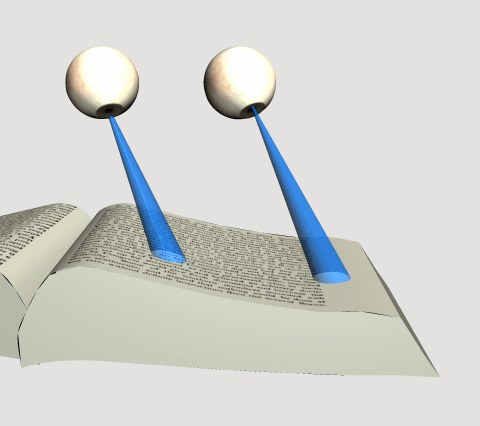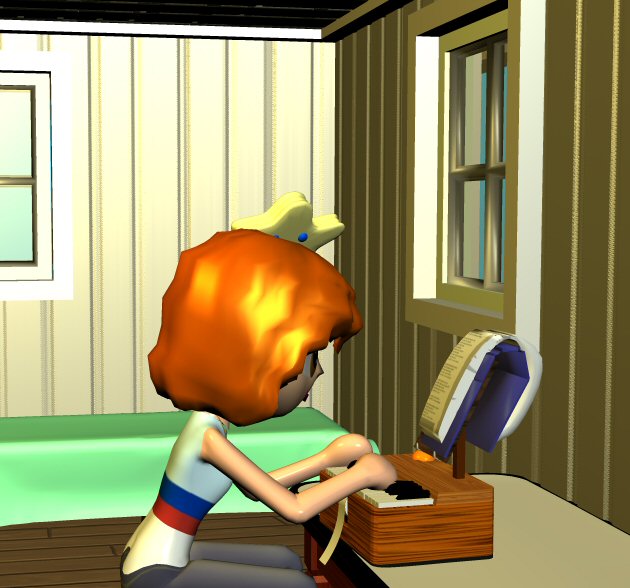Friday, October 18, 2019
Why are books bound horizontally?
Convective thought.
Why are books horizontal?
The rule seems to be:
Writable things are up-down (with some exceptions).
Readable things are left-right, at least in the world of paper.
There's absolutely no advantage to the left-right arrangement of pages for writing or reading. Up-down has all the advantages in both modes.
Think of a legal pad or a drawing pad. Up-down. You flip the pages over and out of the way when done with each page. You can lay it flat on a table or clipboard, and your hand (left OR right) can write consistently across the flat surface.
Think of a hardback book. Left-right. You flip the pages leftward, and the used page is always trying to spring back, so you have to hold it. Worst of all, your eyes have to deal with an inconsistent distance and inconsistent angle and inconsistent glare, which is opposite on the left and right pages.
 When the paper is flat, the eyes and brain have a simpler task.
History doesn't seem to justify the left-right arrangement. We first wrote on clay tablets, which are not bound in either direction. Then we used scrolls, which are continuous up-down. Sometime in the Middle Ages, scribes started binding pages left-right, and the habit continued through the print era.
Computers developed from an up-down tradition.
Typewriters scrolled the paper vertically. Teletypes, starting around 1910, used a continuous roll to avoid constant manual paper insertion. Computers began by using existing teletypes as output, then developed various forms of printers, still with a continuous scroll. CRT monitors started as direct copies of the teletype output, with printed lines scrolling upward just like a roll of paper.
In the web era, a looser range of shapes and formats are possible, but the scroll continues to dominate. The preferred vertical aspect of iPhones forces vertical scrolling.
Despite the total dominance of vertical pages in digital, and in writable paper media, readable paper continues left-right.
= = = = =
Did we ever have up-down hardbound books? Yes, but only in a peculiar niche.
The textbooks we used in typing class in high school were up-down.
When closed, the book laid flat like any other, except that its aspect ratio was inverted.
When the paper is flat, the eyes and brain have a simpler task.
History doesn't seem to justify the left-right arrangement. We first wrote on clay tablets, which are not bound in either direction. Then we used scrolls, which are continuous up-down. Sometime in the Middle Ages, scribes started binding pages left-right, and the habit continued through the print era.
Computers developed from an up-down tradition.
Typewriters scrolled the paper vertically. Teletypes, starting around 1910, used a continuous roll to avoid constant manual paper insertion. Computers began by using existing teletypes as output, then developed various forms of printers, still with a continuous scroll. CRT monitors started as direct copies of the teletype output, with printed lines scrolling upward just like a roll of paper.
In the web era, a looser range of shapes and formats are possible, but the scroll continues to dominate. The preferred vertical aspect of iPhones forces vertical scrolling.
Despite the total dominance of vertical pages in digital, and in writable paper media, readable paper continues left-right.
= = = = =
Did we ever have up-down hardbound books? Yes, but only in a peculiar niche.
The textbooks we used in typing class in high school were up-down.
When closed, the book laid flat like any other, except that its aspect ratio was inverted.
 The front cover had an extra 'hinge' so that it could flop over the stand fully, and the pages were sewn instead of glued into a wide and flexible spine so they could flop easily.
The front cover had an extra 'hinge' so that it could flop over the stand fully, and the pages were sewn instead of glued into a wide and flexible spine so they could flop easily.
 The only disadvantage of this setup is that you couldn't have printing on the back of each page, but the longer aspect ratio meant that each page contained the same number of lines as two normal pages.
= = = = =
Graphic sidenote: Polistra is typing on an early piano-style telegraph sender.
The only disadvantage of this setup is that you couldn't have printing on the back of each page, but the longer aspect ratio meant that each page contained the same number of lines as two normal pages.
= = = = =
Graphic sidenote: Polistra is typing on an early piano-style telegraph sender.
 When the paper is flat, the eyes and brain have a simpler task.
History doesn't seem to justify the left-right arrangement. We first wrote on clay tablets, which are not bound in either direction. Then we used scrolls, which are continuous up-down. Sometime in the Middle Ages, scribes started binding pages left-right, and the habit continued through the print era.
Computers developed from an up-down tradition.
Typewriters scrolled the paper vertically. Teletypes, starting around 1910, used a continuous roll to avoid constant manual paper insertion. Computers began by using existing teletypes as output, then developed various forms of printers, still with a continuous scroll. CRT monitors started as direct copies of the teletype output, with printed lines scrolling upward just like a roll of paper.
In the web era, a looser range of shapes and formats are possible, but the scroll continues to dominate. The preferred vertical aspect of iPhones forces vertical scrolling.
Despite the total dominance of vertical pages in digital, and in writable paper media, readable paper continues left-right.
= = = = =
Did we ever have up-down hardbound books? Yes, but only in a peculiar niche.
The textbooks we used in typing class in high school were up-down.
When closed, the book laid flat like any other, except that its aspect ratio was inverted.
When the paper is flat, the eyes and brain have a simpler task.
History doesn't seem to justify the left-right arrangement. We first wrote on clay tablets, which are not bound in either direction. Then we used scrolls, which are continuous up-down. Sometime in the Middle Ages, scribes started binding pages left-right, and the habit continued through the print era.
Computers developed from an up-down tradition.
Typewriters scrolled the paper vertically. Teletypes, starting around 1910, used a continuous roll to avoid constant manual paper insertion. Computers began by using existing teletypes as output, then developed various forms of printers, still with a continuous scroll. CRT monitors started as direct copies of the teletype output, with printed lines scrolling upward just like a roll of paper.
In the web era, a looser range of shapes and formats are possible, but the scroll continues to dominate. The preferred vertical aspect of iPhones forces vertical scrolling.
Despite the total dominance of vertical pages in digital, and in writable paper media, readable paper continues left-right.
= = = = =
Did we ever have up-down hardbound books? Yes, but only in a peculiar niche.
The textbooks we used in typing class in high school were up-down.
When closed, the book laid flat like any other, except that its aspect ratio was inverted.
 The front cover had an extra 'hinge' so that it could flop over the stand fully, and the pages were sewn instead of glued into a wide and flexible spine so they could flop easily.
The front cover had an extra 'hinge' so that it could flop over the stand fully, and the pages were sewn instead of glued into a wide and flexible spine so they could flop easily.
 The only disadvantage of this setup is that you couldn't have printing on the back of each page, but the longer aspect ratio meant that each page contained the same number of lines as two normal pages.
= = = = =
Graphic sidenote: Polistra is typing on an early piano-style telegraph sender.
The only disadvantage of this setup is that you couldn't have printing on the back of each page, but the longer aspect ratio meant that each page contained the same number of lines as two normal pages.
= = = = =
Graphic sidenote: Polistra is typing on an early piano-style telegraph sender.Labels: Alternate universe, Morsenet of Things
